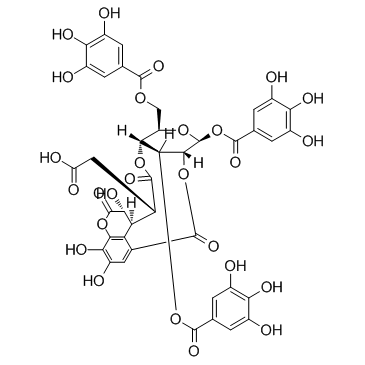Chebulinic acid

Chebulinic acid structure
|
Common Name | Chebulinic acid | ||
|---|---|---|---|---|
| CAS Number | 18942-26-2 | Molecular Weight | 956.677 | |
| Density | 2.0±0.1 g/cm3 | Boiling Point | 1460.0±65.0 °C at 760 mmHg | |
| Molecular Formula | C41H32O27 | Melting Point | N/A | |
| MSDS | Chinese USA | Flash Point | 437.2±27.8 °C | |
Use of Chebulinic acidChebulinic acid is a potent natural inhibitor of M. tuberculosis DNA gyrase, also can inhibit SMAD-3 phosphorylation, inhibit H+ K+-ATPase activity. |
| Name | chebulinic acid |
|---|---|
| Synonym | More Synonyms |
| Description | Chebulinic acid is a potent natural inhibitor of M. tuberculosis DNA gyrase, also can inhibit SMAD-3 phosphorylation, inhibit H+ K+-ATPase activity. |
|---|---|
| Related Catalog | |
| Target |
target: M. tuberculosis DNA gyrase[1], SMAD-3 phosphorylation[2], H+ K+-ATPase activity.[3]IC50: 65.01 μg/ml ( H+ K+-ATPase ) [3] |
| In Vitro | In vitro: binding of Chebulinic acid causes displacement of catalytic Tyr129 away from its target DNA-phosphate molecule. [1] Chebulinic acid reduce the expression and activity of MMP-2 at an ED50 value of 100 μM. EMT (Epithelial to Mesenchymal Transition) is found to be induced in ARPE-19 cells, through SMAD-3 phosphorylation and it is inhibited by CA. [2] chebulinic acid significantly inhibited H+ K+-ATPase activity in vitrowith IC50 of 65.01 μg/ml. [3] |
| References |
| Density | 2.0±0.1 g/cm3 |
|---|---|
| Boiling Point | 1460.0±65.0 °C at 760 mmHg |
| Molecular Formula | C41H32O27 |
| Molecular Weight | 956.677 |
| Flash Point | 437.2±27.8 °C |
| Exact Mass | 956.113098 |
| PSA | 447.09000 |
| LogP | 4.14 |
| Vapour Pressure | 0.0±0.3 mmHg at 25°C |
| Index of Refraction | 1.837 |
| Storage condition | 2-8℃ |
| RIDADR | NONH for all modes of transport |
|---|
|
Anti-secretory and cyto-protective effects of chebulinic acid isolated from the fruits of Terminalia chebula on gastric ulcers.
Phytomedicine 20(6) , 506-11, (2013) In continuation of our drug discovery program on Indian medicinal plants, the gastro protective mechanism of chebulinic acid isolated from Terminalia chebula fruit was investigated. Chebulinic acid wa... |
|
|
Chemical changes during fermentation of Abhayarishta and its standardization by HPLC-DAD.
Nat. Prod. Commun. 5(4) , 575-9, (2010) Abhayarishta is an Ayurvedic formulation prepared traditionally by the fermentation of the decoction of Terminalia chebula (pericarp), Vitis vinifera (fruits), Embelia ribes (fruits) and Madhuca indic... |
|
|
A new phenolic compound, 4-dehydrochebulic acid-1,6-dimethyl ester from Sapium insigne leaves.
J. Nat. Med. 64(2) , 191-3, (2010) A new phenolic compound, 4-dehydrochebulic acid-1,6-dimethyl ester (2) was isolated from the leaves of Sapium insigne (Royle) Benth. ex Hook. fil. (Euphorbiaceae) along with three known compounds gall... |
| 7,11-Methanopyrano[4,3,2-kl][2,5,8]benzotrioxacyclotridecin-4-acetic acid, 2,3,3a,4,5,7,8,10,11,13-decahydro-3,15,16-trihydroxy-2,5,13-trioxo-10,17-bis[(3,4,5-trihydroxybenzoyl)oxy]-8-[[(3,4,5-trihydroxybenzoyl)oxy]methyl]-, (3S,3aS,4S,7R,8R,10S,11R,17S)- |
| Eutannin |
| [(4R,5S,7R,8R,11S,12S,13S,21S)-13,17,18-Trihydroxy-2,10,14-trioxo-5,21-bis[(3,4,5-trihydroxybenzoyl)oxy]-7-{[(3,4,5-trihydroxybenzoyl)oxy]methyl}-3,6,9,15-tetraoxatetracyclo[10.7.1.1.0]hen icosa-1(20),16,18-trien-11-yl]acetic acid |

